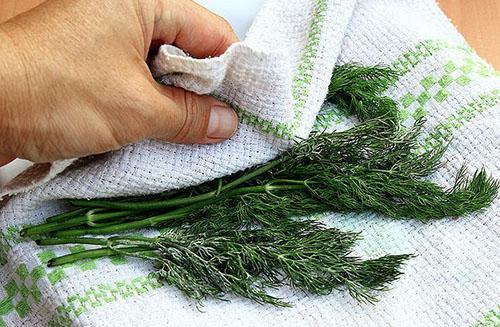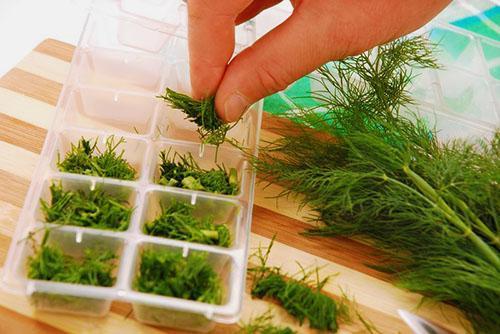Proven and original recipes for preparing dill for the winter
 Dill greens, which appeared on the European territory of Russia in the 10th century, over the past centuries has become one of the favorite spices. The carved fragrant foliage of the umbrella plant is indispensable in fresh vegetable salads, pickles and pickles, potato and cereal dishes. Dill plucked from the garden is an excellent addition to meat, fish and poultry.
Dill greens, which appeared on the European territory of Russia in the 10th century, over the past centuries has become one of the favorite spices. The carved fragrant foliage of the umbrella plant is indispensable in fresh vegetable salads, pickles and pickles, potato and cereal dishes. Dill plucked from the garden is an excellent addition to meat, fish and poultry.
But what to do in the cold season, when beautiful, but sometimes tasteless greens can be found only in stores? It is problematic to keep fresh herbs in a regular refrigerator for a long time. After a couple of days, it turns yellow, loses its appearance and smell, and fades. Therefore, such recipes for preparing dill for the winter are irreplaceable here, where the foliage and stems of the plant are frozen, dried, salted or pickled.
Homemade dill blanks for the winter will come to the rescue. Fortunately, there are ways to preserve the taste, aroma and useful properties of dill grown on our own garden beds, today there are many.
How to freeze dill at home?

Before freezing dill, vegetable raw materials in the freezer:
- washed;
- dry thoroughly by blotting with a napkin or towel;
- free from rough parts of the plant;
- cut;
- distribute into containers or bags intended for freezing;
- placed in a freezer for long-term storage and subsequent use.
 Since greens thaw quickly, but do not tolerate repeated freezing, it is better to choose small containers for storage. You can freeze dill by tightly wrapping small bundles of herbs with cling film. And in order to simplify the use of frozen raw materials, many housewives began to harvest dill ice cubes at home for the winter, containing one portion of spicy herbs for preparing a first course or adding to a side dish.
Since greens thaw quickly, but do not tolerate repeated freezing, it is better to choose small containers for storage. You can freeze dill by tightly wrapping small bundles of herbs with cling film. And in order to simplify the use of frozen raw materials, many housewives began to harvest dill ice cubes at home for the winter, containing one portion of spicy herbs for preparing a first course or adding to a side dish.
Chopped foliage is laid out in ice molds, poured with a small amount of boiled water and sent to the freezer. When the ice hardens, the cubes are put into bags and, as needed, taken out of the freezer.
 For lovers of fish and rice dishes, another recipe for preparing dill for the winter is suitable. The washed greens are crushed in a blender, a little lemon juice and pepper are added to the resulting puree, and the resulting seasoning, after mixing, is poured into ice molds. In this case, the addition of water, most often, is not required, and the resulting ice has a rich taste, which is transferred to ready-made dishes.
For lovers of fish and rice dishes, another recipe for preparing dill for the winter is suitable. The washed greens are crushed in a blender, a little lemon juice and pepper are added to the resulting puree, and the resulting seasoning, after mixing, is poured into ice molds. In this case, the addition of water, most often, is not required, and the resulting ice has a rich taste, which is transferred to ready-made dishes.
Dill in vegetable oil
Vegetable oils, covering the greens, prevent oxygen access to it, prevent the development of pathogenic microbes and molds, so at home you can prepare dill for the winter in vegetable oil.
The easiest way is to chop clean greens, put them in glass containers and pour sunflower or olive oil. It is important that no air bubbles remain in the thick of the greens, and the oil covers the chopped dill. Jars are tightly closed and stored in a dark, cool place.You can use the resulting product for dressing salads, boiled potatoes and pasta.
If desired, the recipe for preparing dill for the winter can be complicated by adding lemon zest, black pepper, and parsley to the composition.
Fresh dill pesto sauce
 On the basis of aromatic dill, they prepare not only such an original dressing, but also a vitamin pesto sauce.
On the basis of aromatic dill, they prepare not only such an original dressing, but also a vitamin pesto sauce.
For 150-200 grams of fresh dill take:
- 3 cloves of garlic, peeled;
- 1/2 teaspoon salt
- 1/4 cup shelled pine nuts
- 1/4 teaspoon ground black pepper
- 1 teaspoon finely grated lemon zest
- 1/4 cup olive oil
 All ingredients are thoroughly ground in a blender, mixed, laid out in small jars and closed after sterilization. Such a homemade dill preparation will decorate dishes of red and white sea fish, risotto and pasta, and can also serve as a dressing for vegetable, potato and mushroom puree soups.
All ingredients are thoroughly ground in a blender, mixed, laid out in small jars and closed after sterilization. Such a homemade dill preparation will decorate dishes of red and white sea fish, risotto and pasta, and can also serve as a dressing for vegetable, potato and mushroom puree soups.
If you don't have pine nuts on hand, walnut kernels, almonds or even peanuts are great substitutes.
Oil with spicy dill for the winter
 Dill oil will be another good help in winter; at home it can be made in several ways. Olive oil or sunflower oil can be used instead of water when freezing dill cubes in the freezer. Such a preparation is extremely convenient to use, retains all the aromatic and taste properties of greens and does not take much time to prepare.
Dill oil will be another good help in winter; at home it can be made in several ways. Olive oil or sunflower oil can be used instead of water when freezing dill cubes in the freezer. Such a preparation is extremely convenient to use, retains all the aromatic and taste properties of greens and does not take much time to prepare.
 Instead of olive, you can use melted butter. In this case, the cubes will give the potatoes a fresh summer flavor and add a great creamy flavor.
Instead of olive, you can use melted butter. In this case, the cubes will give the potatoes a fresh summer flavor and add a great creamy flavor.
The oil helps keep dill harvested for the winter fresh. For several months of storage, greens do not lose their color, smell, or taste.
 Likewise, these cubes work well for serving baked fish portions, making sandwiches, and other dishes. The photo shows the ingredients for making a snack butter with dill, lemon zest and garlic. All plant components are crushed and added to softened butter, after which they are mixed and spread on cling film.
Likewise, these cubes work well for serving baked fish portions, making sandwiches, and other dishes. The photo shows the ingredients for making a snack butter with dill, lemon zest and garlic. All plant components are crushed and added to softened butter, after which they are mixed and spread on cling film.
 The resulting product is formed into a bar and frozen. Often a little salt, pepper and other spices are added to such mixtures according to your taste and needs. Moreover, the dill in the preparation for the winter remains as fresh. Homemade dill oil with chunks of bell pepper and pickled capers makes a great addition to crispy toast, potatoes, or boiled rice.
The resulting product is formed into a bar and frozen. Often a little salt, pepper and other spices are added to such mixtures according to your taste and needs. Moreover, the dill in the preparation for the winter remains as fresh. Homemade dill oil with chunks of bell pepper and pickled capers makes a great addition to crispy toast, potatoes, or boiled rice.
But the famous essential dill oil cannot be prepared at home. But on the dried herbs and seeds of the plant, olive or other vegetable oil can be infused. Dry dill sprigs and seeds are poured with oil, tightly covered with a lid and left to infuse in a dark place for 7-10 days. As a result, the oil will acquire a delicate aroma, which will certainly be transferred to the prepared dishes.
In this case, dry plant material is most preferable, since it does not contain moisture, gives off aromatic substances more quickly and cannot cause acidification or the development of mold.
How to dry dill at home?
 Drying is the most popular preparation method. But the herbs of the herbs are extremely delicate.When overheated, the dill quickly turns yellow and loses all its dignity. It is important to remember this, and, when going to dry the dill at home, choose a suitable ventilated place away from sunlight and heating appliances.
Drying is the most popular preparation method. But the herbs of the herbs are extremely delicate.When overheated, the dill quickly turns yellow and loses all its dignity. It is important to remember this, and, when going to dry the dill at home, choose a suitable ventilated place away from sunlight and heating appliances.
 Before dill greens are dried at home, they are washed, soaked with a napkin and cut, simultaneously removing tough stems and umbrellas. Trays with grass or drying bundles should be protected from insects and wind. To do this, it is easier to use gauze or other lightweight fabric that allows air to pass through.
Before dill greens are dried at home, they are washed, soaked with a napkin and cut, simultaneously removing tough stems and umbrellas. Trays with grass or drying bundles should be protected from insects and wind. To do this, it is easier to use gauze or other lightweight fabric that allows air to pass through.
If the dill is dried in specialized dryers, the most gentle temperature regimes are chosen, and the greens are spread in a thin even layer.
How to salt dill in jars for the winter?
 Dill can be salted with brine or dry. Before you salt the dill for the winter in jars, wash the foliage. For a kilogram of chopped greens, 200 grams of salt are taken, plant raw materials are laid out in layers in glass containers, sprinkled with salt, tamped and a new layer of secluded leaves is made. When the jar is full, cover it with wax paper and set it out in the cold.
Dill can be salted with brine or dry. Before you salt the dill for the winter in jars, wash the foliage. For a kilogram of chopped greens, 200 grams of salt are taken, plant raw materials are laid out in layers in glass containers, sprinkled with salt, tamped and a new layer of secluded leaves is made. When the jar is full, cover it with wax paper and set it out in the cold.
Dill prepared for the winter according to this recipe does not lose its aroma for up to 2-3 months and can serve as a seasoning for almost any dish.
For the best juice yield and a very aromatic seasoning, you can add lemon juice to the chopped dill and grind the raw materials with salt.
Dill greens in marinade
 After grinding, dill greens and young parts of the stems are poured with marinade with the addition of vegetable oil, sterilized and covered with tightly ground lids. For a kilogram of fresh herbs they take:
After grinding, dill greens and young parts of the stems are poured with marinade with the addition of vegetable oil, sterilized and covered with tightly ground lids. For a kilogram of fresh herbs they take:
- 300 grams of water;
- 3 tablespoons 6% vinegar
- 30 grams of table salt;
- 50 grams of vegetable oil.
Pepper, bay leaves and other spices are added to taste. Such preparation of dill for the winter at home is stored in a basement or cellar and can be used as an independent snack or a spicy addition to dishes made from meat, mushrooms and vegetables.